

![]() SAR Technology: 'Incident
Commander' Software
SAR Technology: 'Incident
Commander' Software
Sherbrooke Police SAR Team Reach New Heights using 'Incident Commander Pro' Software
Rescuers Reach New Heights
By Pierre Saint-Jacob
![]() La Tribune
La Tribune
Sherbrooke, Quebec.
|
Andre Lemire, instructor of the Sherbrooke Police SAR (SPS) Team, holding the unique 'Incident Commander' software, which contains 44 profiles of lost person behavior. |
![]() Few citizens know that the Sherbrooke Police has a SAR team
which is the envy of many police forces across North America.
Few citizens know that the Sherbrooke Police has a SAR team
which is the envy of many police forces across North America.
The Sherbrooke Police (SPS) SAR Team of five police officers, assisted by
members of the Emergency Response Team, has over the years developed methods and
strategies for searching that have been recognized by the National Search & Rescue
Secretariat, in Ottawa, Canada.
The criteria and techniques used by the team in Canada are very similar to those used
across the United States and even in Europe. The team members are trained according to
techniques that are conducted in the same manner whether they are in Texas, Vancouver or
the European forests.
The fledgling group of what has now developed into a sophisticated SAR team, was initially
comprised of five police officers from Rock Forest, Quebec who, after a tragic incident 10
years ago, decided to form a SAR team able to respond at very short notice.
Among these police officers are Sergeant Yvon Charpentier, who has broad
field experience, and André Lemire,
who helped organize the team and acquired cartography skills while training in the armed
Forces.
During the integration of the Rock Forest Municipal Safety Program with the Sherbrooke
Police SAR Team, the team brought their 'toolkit' of experience with them. The SPS
SAR Team has taught many police officers and firemen from around the towns of
Sherbrooke, Bromptonville, Deauville and Lennoxville. This 'toolkit of experience'
increases and continues to improve over time.
The SPS SAR Team can count on 75 people trained with specialized SAR
skills and can also count on additional help from members of the Sherbrooke Armed Forces
Reserve. Each year there is a re-certification program to ensure that the team members
remain familiar the concepts of search and rescue, while also learning of the latest
developments in this field.
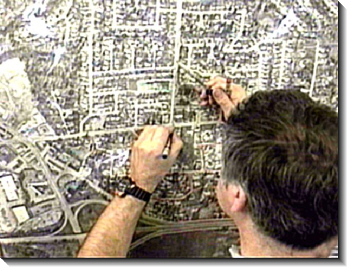 Searching
in the Urban Environment
Searching
in the Urban Environment
According to whether one is searching in urban environment or in a wilderness forest,
the search techniques may vary but the strategies will remain the same. The SPS
SAR Team has just acquired the unique
'Incident Commander'
software, which makes it possible to develop mathematical predictions
regarding missing person behavior.
"If we are informed that a child of a certain age, weight, and size disappeared
around, say, 1300hrs our calculations can be confirmed by the software, which makes it 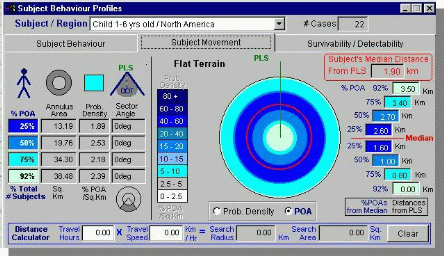 possible to
determine that the child travelled 800 meters in one hour, 1,6 kilometer in two hours and
so on. If the child has been missing for one hour then we can conduct a door-to-door
search on foot, distributing flyers and searching stores and shopping centres within in a
radius of 800 meters. If the distance is much larger then vehicles will patrol the
perimeter and move inwards from this radius towards the Point Last Seen", explains
the police officer André Lemire. The 'Incident
Commander' software calculations make it possible to
validate the decisions taken, and to help confirm the detailed planning of the search
management team.
possible to
determine that the child travelled 800 meters in one hour, 1,6 kilometer in two hours and
so on. If the child has been missing for one hour then we can conduct a door-to-door
search on foot, distributing flyers and searching stores and shopping centres within in a
radius of 800 meters. If the distance is much larger then vehicles will patrol the
perimeter and move inwards from this radius towards the Point Last Seen", explains
the police officer André Lemire. The 'Incident
Commander' software calculations make it possible to
validate the decisions taken, and to help confirm the detailed planning of the search
management team.
There are approximately ten disappearances annually within the urban environment region
patrolled by the SPS SAR Team. Typically these missing people are found
within about three hours. More often than not these are either children or people
suffering from the Alzheimer's disease.
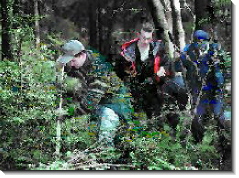 Searching
in the Forest
Searching
in the Forest
"For a person missing in a forest, one would take the most information
available on the person, their physical condition and the equipment they would have taken
with them. Then one would try to establish the distance travelled. If there is a lake in
the sector, it would be dredged, If there is a campsite, it would be visited." The
calculations would then be analysed by the 'Incident
Commander' software, to obtain confirmation on whether the
selected search plan would be effective.
For searching in forest, one may also decide to perform a 'corridor' gridsearch.
The Lemire police officer explains that the initial search is typically carried out using
an open-grid 'Sound Sweep': over a one-kilometer width four police officers advance and
then stop every minute, blast their whistles, listen for a possible response from the
missing person, and then repeat the process.
"During this time, we may also prepare for a close-grid search. The search
'corridors' are typically 30 meters wide, inside which walk ten police officers. Each
corridor is traversed in the two directions, at right angles to each other. In this way
the entire defined area will be searched."
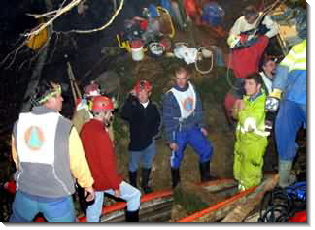 Night
Searching
Night
Searching
Last year, in Laval, the SPS SAR team received training from Vancouver-based
night-search specialists.
"The decision to perform a night search will be dictated by the urgency of the
situation: If a six year-old child is missing in heavy forest, after nightfall, with
temperatures hovering around 3 degrees Celsius with light rain, then it is necessary to
act."
Within some limitations, using night vision goggles the team one may develop a plan to
search at night almost as if it was daylight. One group searches using night vision
goggles while another searches using flashlights.
![]() As statistics show that the majority of people stray off travelled paths
the searchers may install a trip-wire across a path, which is connected to switch on a
flashlight. When the cord breaks, by someone walking into it, the light makes it possible
for the lost person to find shelter, water and food placed at this location, along with a
message that help will come within an hour or so. The illumination will last for about 60
minutes. When the searchers return, if they see that the tripwire has been broken by an
animal, they will reset the mechanism.
As statistics show that the majority of people stray off travelled paths
the searchers may install a trip-wire across a path, which is connected to switch on a
flashlight. When the cord breaks, by someone walking into it, the light makes it possible
for the lost person to find shelter, water and food placed at this location, along with a
message that help will come within an hour or so. The illumination will last for about 60
minutes. When the searchers return, if they see that the tripwire has been broken by an
animal, they will reset the mechanism.
If the territory is too large to be searched on foot the search team will perform a
vehicle-based patrol, occasionally sounding their sirens to alert and direct the missing
person.
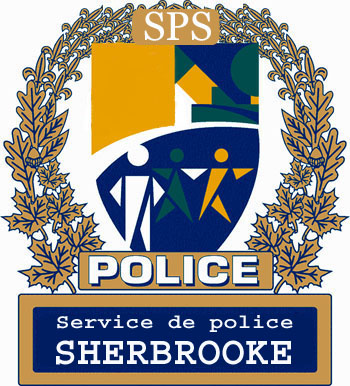 The
SPS SAR Team will also assist the Criminal Investigations Division and
the Criminal Service's office at a crime scene, to help conduct an evidence search. They
will often wait until nightfall to use ultraviolet lamps in order to more easily detect
small clues, such as bone fragments.
The
SPS SAR Team will also assist the Criminal Investigations Division and
the Criminal Service's office at a crime scene, to help conduct an evidence search. They
will often wait until nightfall to use ultraviolet lamps in order to more easily detect
small clues, such as bone fragments.
![]() It is easy to understood why, with real pride, that the SPS SAR
Team is unique in Quebec in having reached this very high skill level.
It is easy to understood why, with real pride, that the SPS SAR
Team is unique in Quebec in having reached this very high skill level.
![]() SAR Technology Inc.
SAR Technology Inc.
 Phone:
(604) 921-2488
Phone:
(604) 921-2488  Fax
(604) 921-2484
Fax
(604) 921-2484 ![]() sartechnology@telus.net
sartechnology@telus.net